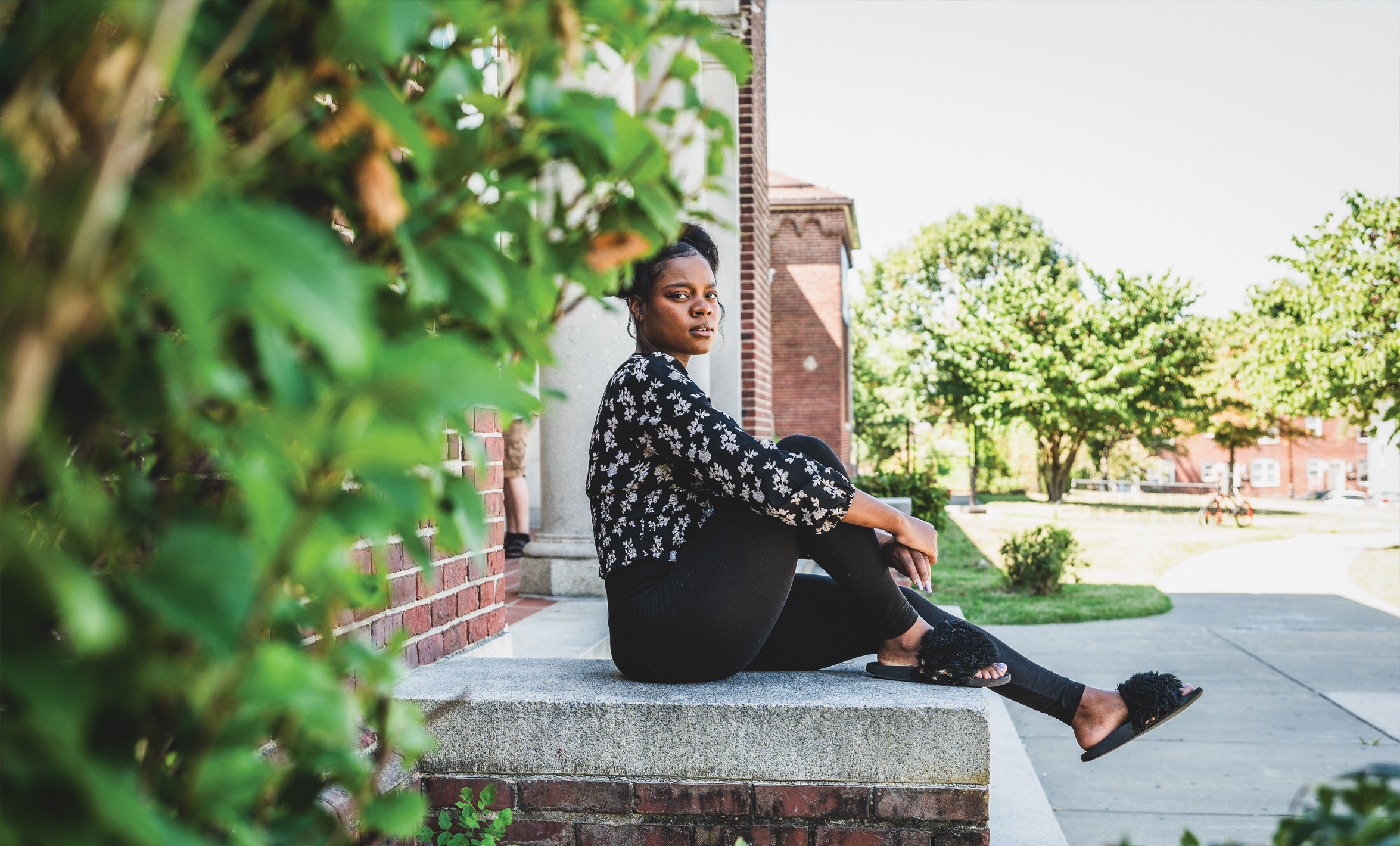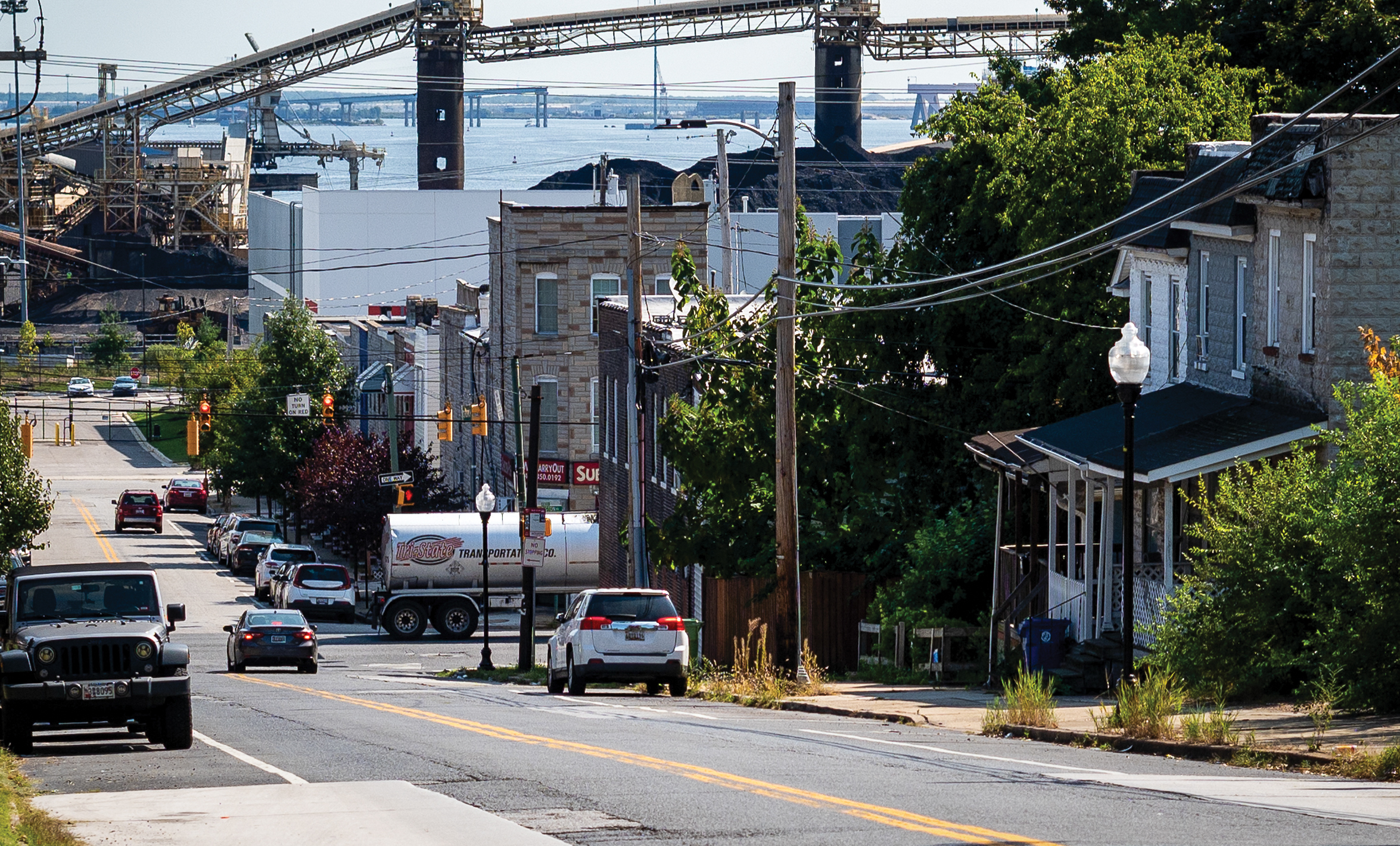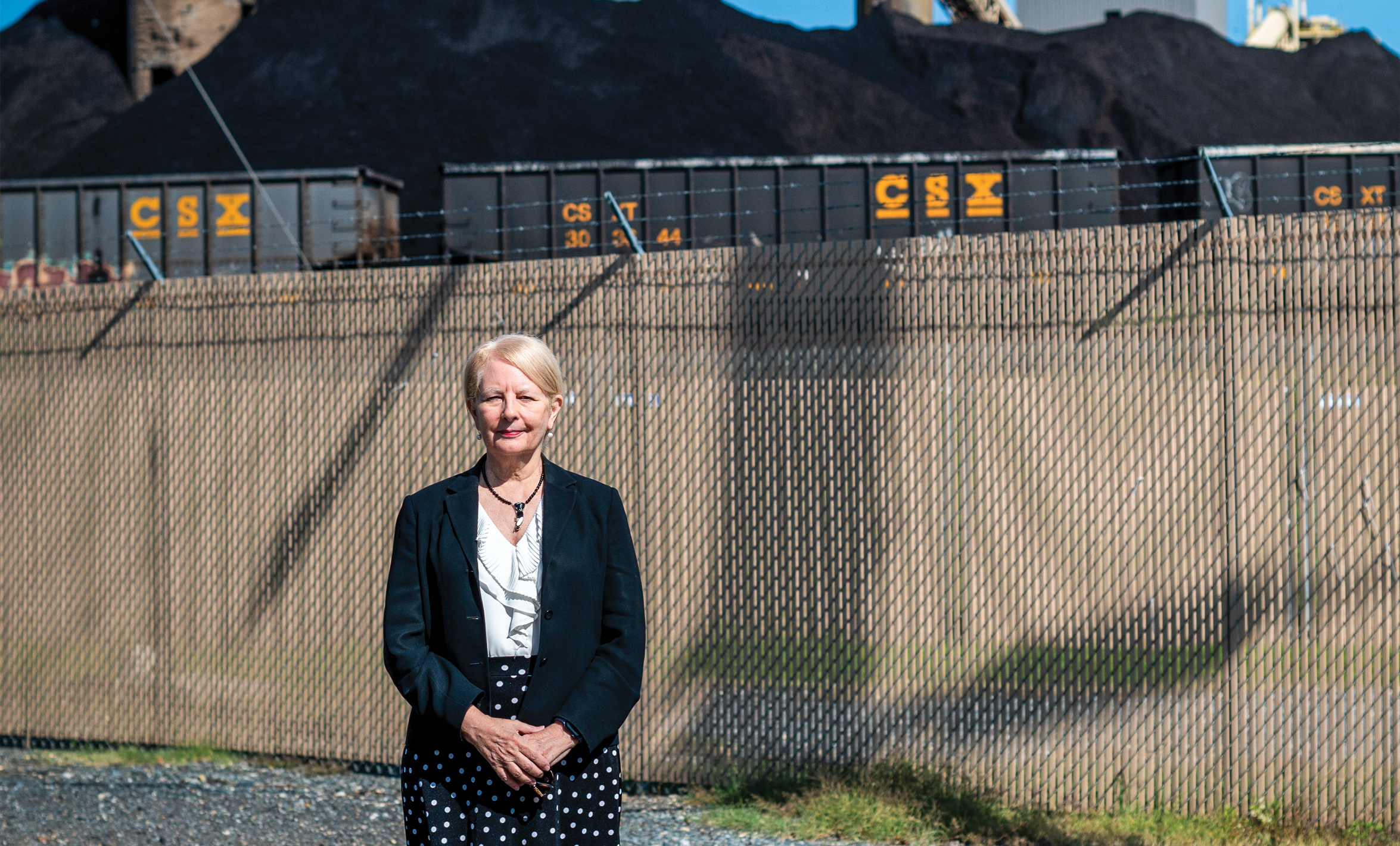Community vs. Coal: Reclaiming Health in Curtis Bay
Protesting coal dust and half-burned medical waste, South Baltimore residents lead the way on environmental health research.
Vilma Gutierrez is a shy, quiet girl. When she speaks, others find themselves moving toward her, tilting their heads to catch the 17-year-old’s gentle words.
But in June, she finds herself clutching a microphone in front of a crowd outside the Curtis Bay recreation center in South Baltimore, asking the international corporation CSX to stop polluting the area’s marginalized and overburdened communities.
Nearby, children clamber onto a circus-colored playground glinting in the sun. A few hundred feet away, trains clank across a dozen crisscrossing tracks, looping around their nucleus: a series of four-story-high heaps of coal. The mountains of Appalachia gutted and reconstituted in South Baltimore.
When the wind lifts the dust in eddying clouds, it looks like ocean waves rolling across the sky, one resident says.
The dust blows from the massive coal piles and from the open cars of screeching trains, and it settles on everything: plastering windows, coating water in children’s inflatable pools, and slipping into homes when doors swing open. It’s sucked into lungs, sending breathless children to the hospital. Residents have high rates of asthma, lung cancer, heart disease, and chronic lower respiratory disease, and their life expectancy is almost four years less than Baltimore’s average.
Yet CSX denies the black substance is coal, arguing instead that it’s diesel residue or other pollutants—or even soil or pollen.
The people of South Baltimore are pushing back.

Last summer, Gutierrez volunteered with the community group Free Your Voice, in partnership with Johns Hopkins’ Community Health: Addressing Regional Maryland Environmental Determinants of Disease (CHARMED) Center and the University of Maryland, to understand what the dust really was.
CHARMED asserts that people are experts on their communities. They know, for instance, that air pollution might be lower on one street than another because of traffic patterns, and they can help researchers create better models and experiments based on this knowledge.
“Our role is helping the communities obtain scientific evidence and then advocating with them for some kind of action to be taken on a policy level,” says Marsha Wills-Karp, PhD, MS, director of CHARMED and chair of Environmental Health and Engineering.
What Gutierrez and other volunteers did was disarmingly simple: They installed sticky strips of white poster tape and special carbon tape on residential buildings in the Curtis Bay, Lakeland, Brooklyn, and Mount Winans neighborhoods. For a month, the rough black dust accumulated on the strips; sometimes, it appeared on the strips within seconds.
CHARMED scientists used electron microscopy to confirm what members of the community knew all along: It was coal.
“We do have scientific evidence that it was detectable and we want to stop this—we want to stop it now,” Gutierrez says at the protest.
“People like me, we don’t have a big voice. We just don’t have the power,” Gutierrez says, haltingly at first, but then her words start to gain momentum. “People don’t really listen to people who come from low poverty. We are fighting against a lot of people who do have a lot of money, who do have a lot of connections. We are still always trying to fight back.”

‘We’re not lying. You cannot get out of this.’
The Port of Baltimore is the second-largest export hub of coal in the nation, and shipments of sought-after Appalachian coal are soaring. When an explosion rocked Curtis Bay in 2021, all eyes turned toward the coal terminal.
“Things always get attention when they explode,” says Shashawnda Campbell, director of environmental justice at the South Baltimore Community Land Trust.
Residents learned the explosion was caused by a buildup of methane in the coal piles. But no one came out to tell the community what was going on, Campbell says. They had to start asking questions, and once they started, they didn’t stop. Why was all that coal piled up, uncovered, like that? Why was it allowed to blow over the homes and into the lungs of residents? How could they prove the negative effects it was having on their health?
“We know what the questions are, but we don’t know how to actually do this research,” Campbell says.
The faculty working at CHARMED had been involved in research in South Baltimore since 2013 or so, and community members approached them after the explosion. The community and the scientists developed several research questions about the coal terminal: Was it indeed coal dust blowing into the communities? How quickly was it accumulating? And did it create health and environmental burdens? In addition to the sticky strips, they also installed air quality monitors near the fence line of the facility. Their research indicated the coal dust was pervasive. “It basically went throughout the South Baltimore community,” Campbell says.
The research with CHARMED wasn’t just some “weird feel-good project,” she says. “This was a real project that actually yielded these different evidence sources. ... We’ve been able to open doors we hadn’t been able to get into for a while with this research.” CSX and local leaders aren’t just hearing anecdotes from residents. “There is research behind us. We’re not lying. You cannot get out of this,” she says. “Once you know something, you have to do something about it. If you don’t do something about it, you’re saying you do not care.”
CSX uses water sprayers to try to keep some of the dust in place when the wind picks up, but residents haven’t observed a difference. They’re asking CSX to cover the terminal and the trains.
“They also ship it on open train cars, so it’s blowing all the way across the country, too,” Wills-Karp says. “They’re a $30 billion company; you’d think they could spare a little bit of money to contain that coal. That’s all we’re asking at this point: Just don’t let it blow all over the community.”

Another Kind of Pollution
When residents of Mount Winans heard about the community research partnership, they wanted in. The trains carrying coal rumble only a few feet from some of their houses, and the coal dust spreads into their community as well.
And they had more ideas for the researchers. They weren’t concerned only about air pollution. In fact, their biggest concern is the noise pollution from trains constantly roaring past their homes, idling and revving for hours in the middle of the night, and sounding ear-splitting horns.
“Can you imagine having a train going 25 feet from your house in the middle of the night?” asks EHE Professor Gurumurthy “Ram” Ramachandran, deputy director of CHARMED. That would be loud enough, he says, but train operators are mandated to sound their horns three times when they begin moving forward, “and train horns are incredibly loud.” Sleep duration and quality have major effects on cardiovascular health and cognition. The researchers are now setting up a project to measure noise and air pollution.
Because of the community leadership, researchers are now examining more nuanced scientific questions. “There is never just one issue that needs to be addressed, which is how scientific research traditionally got done. This is a much more complicated issue—and that’s how the science gets improved,” says Ramachandran, PhD, MS. “We got many perspectives that we had missed looking at it from the outside. I wish more science was done this way.”
“We’re not always, as physicians or researchers, exactly spot-on with what we think to be important,” says Nirupama Putcha, MD, MHS ’12, a pulmonary physician in the Johns Hopkins School of Medicine working to design these studies. “We may not really fully understand or recognize what a community is experiencing, and we really need those concerns to come primarily from a community.”
Communities in and around Baltimore have been disproportionately affected by adverse environmental issues like pollution, and the placement of industry within these neighborhoods further marginalizes the communities, says Ana Rule, PhD ’05, MHS ’98, assistant professor in EHE. Residents in these communities have worked for decades to understand how pollutants are affecting their health. “They know they’re exposed, they know this is a bad situation,” Rule says. Often, a few members of the community try to do as much research as they can, keeping everyone else informed and sharing resources. “So, they were really open to us coming in to help. It was like, ‘Oh, yes, we’ve been trying to learn about what the exposures are in our community.’”
And community members want to know how the results will help them. “That’s the goal of this type of research, to push academics to think more pragmatically,” Putcha says. “You’re getting pushed to really try to use the information you’re getting and be efficient about it. If you’re asking the communities for the privilege of gathering that information, you better use it, right?”
Citizen science is the only way they could accomplish as much as they have, Rule says, but more people—volunteers or paid positions—would be a huge help to take measurements, or to check on monitors, recalibrate them, and send them for repairs as needed. “We don’t have the number of hands and time in the day to do all the things that need to be done,” she says.
Frequently, the studies are done with relatively low-cost technologies. In Mount Winans, the researchers installed apps on residents’ cell phones to track noise variability, and they’ve also looked into noise detectors—the kind of devices used by people who manage properties, like Airbnb rentals, to see if tenants are having parties. “A lot of my research is, can we use some of these lower-technology solutions, accept their limitations, but also be able to take advantage of them?” says Kirsten Koehler, PhD, MS, professor in EHE and lead of CHARMED’s exposure characterization and modeling core.

17 Hours of Hazardous Smoke
But evidence of wrongdoing doesn’t mean problems will be fixed—at least, not immediately.
Less than five miles from the coal terminal, a medical waste incinerator puffs a cloud of smoke. The emissions are supposed to be white steam; dark smoke means the waste has not been fully incinerated and could pose health risks to anyone who breathes in the soot. “It’s medical waste, which means potentially it could contain harmful organisms,” says Ramachandran.
Yet it frequently exudes a dark cloud, and sometimes debris floats down to the neighborhoods, scattering all over the ground.
Curtis Bay Energy, the incinerator’s operator, was criminally charged by the Attorney General of Maryland for not fully burning the potentially infectious trash, and the company pleaded guilty in October 2023. They were fined $1.75 million. “It was just spewing all over the place. It’s pretty egregious,” says Wills-Karp.
But in early 2024, residents took researchers and EHE students on a “toxic tour” of Curtis Bay, and they pointed out the dark cloud billowing from the smokestacks. They asked CHARMED if they could gather proof that the incinerator was still violating regulations.
The community and CHARMED researchers set up video cameras to watch the incinerator for two weeks in February and March 2024. During that time, thick black smoke emerged from the stacks 27 times, for an average of 40 minutes each—a total of 17 hours of hazardous violations. Residents continued seeing the smoke after the cameras came down.
They believe the operators, in a bid to save money, turn the temperature down on the incinerator. This would mean it doesn’t properly incinerate everything. “They know that’s not legal,” Wills-Karp says. “Even the attorney general knew this was just not acceptable. But they haven’t followed up on making them comply, and that’s why the community is so upset. … We just want them to contain it so they’re not exposing people.”
Hopkins researchers shared their findings with the Maryland Department of the Environment (MDE) and presented the results at a city council meeting in March. Maryland is now seeking to impose additional fines on the incineration company.
The Curtis Bay incinerator, the largest medical-waste incinerator in the country, has the capacity to dispose of one-third of all medical waste in the U.S. The majority of the waste comes from outside of Maryland, including from Canada. But two local hospital systems contributed waste: MedStar and Johns Hopkins. While Johns Hopkins ended its agreement with the incinerator, MedStar did not.
When a company is found to be involved with environmental hazards like these, they may hesitate to admit wrongdoing, Wills-Karp says. But “the community already knows you put stuff there. So now you need to say, what can you do to be part of the solution?”

‘The same air we all breathe’
After collecting and analyzing the dust in Curtis Bay, CHARMED, with the University of Maryland and MDE, released a report in December 2023 confirming the substance is coal dust and concluding that Curtis Bay and other neighborhoods bear a disproportionate burden of pollution. The authors pointed out that there are no safe levels of fine particulate matter like coal dust, according to the WHO and the U.S. EPA.
But instead of taking action, CSX challenged the state-backed findings. The company said in a statement that there’s no evidence the coal dust is present in the community or that it has a significant effect on air quality, and said the research “relied on flawed approaches to draw unfounded conclusions.”
For U.S. Rep. Kweisi Mfume, the former NAACP president and CEO who has represented Curtis Bay since 2022, that was the hardest part to believe. “To discredit the studies that have been done, and by reputable organizations, that’s what I find so amazing,” he says.
“Coal dust has to be significantly reduced, if not eliminated, so that persons living in these communities can continue to breathe,” says Mfume. “I’m going to do everything that I can to represent their concerns here and to fight like hell to make sure that the federal government finds a way to protect individuals, their environment and, quite frankly, their life and their lifestyles by doing what’s right.”
Mfume also wants to establish a federal standard for covering coal cars, which he compared to regulations on indoor smoking and auto emissions that have been proven to harm health.
On August 29, Maryland released a draft permit for two weeks of public comment. The permit would require CSX to construct a physical barrier around the coal heaped up at the terminal, but not a covering from above. The permit would also require CSX to spray water on the coal cars when they enter the facility.
Mfume says it doesn’t go far enough. “CSX believes that they can construct a wall barrier that would prevent the problem that we have right now, and that was never requested,” he said. Instead, the community has asked for the company to cover the coal piles and the train cars.
Campbell, the community organizer, wants CSX to be fined for every day that it releases coal dust into nearby neighborhoods. “This is not a one-off event, like the explosion that happened,” she says, for which the company was fined. It’s “a continuous event that they should constantly be paying for.” In September, for instance, MDE issued a notice of violation after residents observed a cloud of dust generated along the railroad tracks near the terminal.
For Campbell, the fight isn’t just about coal dust or noise levels or medical waste. It’s existential.
There used to be three communities not far from Curtis Bay—Fairfield, Wagner’s Point, and Hawkins Point—with long-standing traditions of fishing, harvesting pears from trees, and going to church together. When more industry moved in over the past few decades, the residents fought back. “People said no. People risked their lives,” Campbell says. But eventually, all of the residents had to leave; the last house was torn down in 2017. Now the region is entirely industrial—including a hazardous waste landfill, chemical manufacturers, and a Superfund site.
“If you go down there, you would never imagine that there was a pear tree, ever,” Campbell says—much less a vibrant community. She doesn’t want Curtis Bay or Mount Winans or Brooklyn or Lakeland or anywhere else to have the same fate.
“It’s affecting all of us. Even if you don’t directly live in Curtis Bay,” Campbell says at the protest. “No matter where you live, the air is going to flow. You’re breathing in the same air we’re all breathing in. This is your fight just as much as it’s ours.”
She is fighting corporate pollution, yes, but really she is fighting for the right to breathe. The right to live.
As Gutierrez, Campbell, and others march through the streets of Curtis Bay in June, holding giant drawings of blackened lungs and chanting “Shut it down,” people come out of their houses to watch. Most stay on their porches, watching the protest sweep by like a parade, but some begin trailing behind the protesters.
One woman standing on her porch spots a neighbor joining the march. “What are you doing?” she yells, her tone teasing.
Her friend grins back, a little embarrassed, but more defiant. “I’m marching! I want that coal factory gone!”
The woman shrugs. “It’s been here forever.”
Her friend nods, but she keeps walking. She says: “It’s only a matter of time.”
